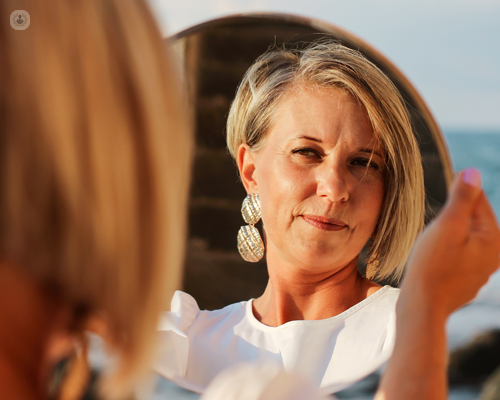The menopause and hair loss
Escrito por:Hair loss during the menopause, or at any time in life, can be upsetting and alarming. It’s reassuring to know that, while it may be something we can’t have full control of, there are ways to slow it down and, in suitable cases, restore it.
Here to discuss the ins and outs of the management of menopause-related hair loss is expert hair restoration surgeon Dr Greg Williams.

Is it a common occurrence to have hair loss during the menopause?
It’s relatively common to have hair loss during menopause and perimenopause (i.e., around menopause). Losing some hair volume is a natural part of the female ageing process, in general. However, it is estimated that around 40 per cent of women who are 50 years or over experience female-pattern hair loss. This is the most common type of hair loss in women and is thought to be inherited.
How does hair loss that’s related to the menopause present itself?
Rather than noticeable balding areas, which is typically around the front or crown of the head in men, most women experience overall hair thinning which is more prominent towards the front of the top of the head and less severe in the central part of the back of the head. Depending on the frequency of brushing and shampooing, hair shedding may seem to occur in alarmingly large volumes.
Why is hair loss caused by the menopause?
Oestrogen, a hair-friendly hormone that helps to keep hair in its growing phase, is lower in menopause. Although the exact cause of hair loss during menopause is not known, one of the thoughts is that decreased levels of oestrogen means that hair grows more slowly and becomes thinner.
This drop can also mean the that the balance between androgens (male hormones) and female hormones changes. The relative increase in male hormones might cause the hair follicles to shrink, producing hairs that decrease in diameter.
If you are using hormone replacement therapy (HRT) then it is important that the practitioner prescribing these selects one that is hair friendly.
When it comes to menopausal hair loss, are hormones the only factor?
No. They may be a significant part of menopausal hair loss, but for some women other contributing factors can make shedding worse, such as:
- Nutritional deficiencies
- Medical conditions
- Medications being taken
- Stress
Hair loss can certainly be caused by some medical conditions such as hyperthyroidism (overactive thyroid) or hypothyroidism (underactive thyroid), so it’s always worth seeing your GP in order to check your overall health.
It is possible to manage menopausal hair loss without? Are there different methods to do this?
There are medical and non-medical ways to manage menopausal hair loss.
It’s crucial at every age to eat a healthy, balanced diet and perhaps consider taking an appropriate multivitamin that contains iron, zinc, and vitamin D which are all important for hair health. Ensure you eat plenty of protein, whole grains and vegetables, as this may help - especially if your hair loss has been exacerbated by poor dietary habits.
Another way to balance your overall hormone levels is to exercise and keep your stress levels in check. Finding something that can help you relax is a good idea. Yoga, breathing exercises and staying active can be effective.
What are the medical treatment options available for menopausal hair loss?
Menopausal hair loss can be combatted using many treatments that are available. Non-surgical solutions available include:
- Lotion, foam or tablets work for many women.
- Finasteride oral medication. Although only licensed for male hair loss because of the risk of birth defects, in some menopausal women it may help.
- Other prescription drugs with anti-androgen activity. Spironolactone, for example, might help in some cases but patients need to have plasma sodium and potassium levels monitored with periodic blood tests.
- Low Level Laser Therapy. Thought to work by encouraging hair cells to produce more protein although the light has to adequately penetrate the scalp to do so.
- Platelet rich plasma (PRP). This involves a component of the patient’s blood rich in growth factors being re-injected into their scalp.
However, none of these options will have the same benefit as hair transplant surgery which can be very effective in suitable patients looking for a permanent solution to thinning hair.
Although many women do find that female pattern hair loss will slow down, hair transplant surgery can be life changing if you are looking for a permanent solution to restore thicker hair.
If you have significant hair loss and want to consider a hair transplant, get in touch with Dr Greg Williams at the Farjo Hair Institute via his Top Doctors profile.



